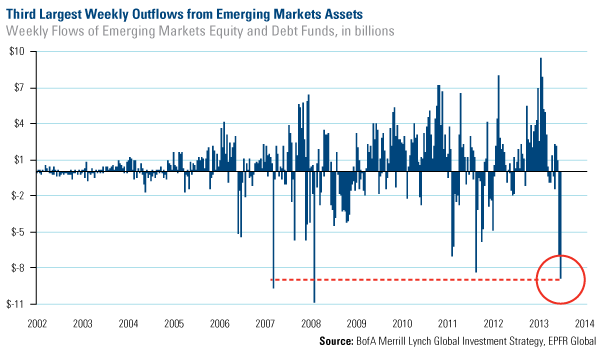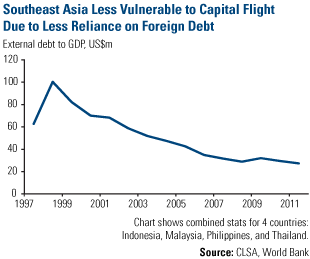Emerging Markets Radar (June 24, 2013)
Strengths
- Russian President Vladimir Putin’s encouragement to increase the nation’s links to China materialized this week as Russian companies signed deals to supply China with crude oil and natural gas. Rosneft, the largest Russian oil producer, agreed to provide more than 2.6 billion barrels of crude oil to China over the next 25 years. Similarly, Beijing agreed to buy a 20 percent stake in a large liquefied natural gas project owned by Novatek, Russia’s second largest gas exporter. It is worth noting that China was responsible for 77 percent of the growth in global energy demand last year. This also provides business opportunities for Chinese domestic pipeline and energy service companies.
- In its second assessment of global shale resources, World Shale Gas and Shale Oil Resource Assessment (June 10, 2013), the U.S. Energy Information Administration (EIA) has again ranked China as the largest source of technically recoverable shale gas resources (1,115tcf, or 32tcm). The EIA has also introduced China as being ranked third globally for technically recoverable shale oil (32 billion barrels). Chinese domestic oil and gas field service companies will benefit in revenue and earnings growth once China starts to develop.
- China state council has issued 10 policy items to support solar energy, in which smart grid construction will accommodate alternative energy to be on grid.
- Macau’s gaming sector continues to do well with year-over-year revenue growth averaging 14 percent year-to-May and June, seemingly on track for 20 percent growth. The enclave’s casino operators benefit from tight industry supply, which allows them to convert revenue growth into earnings growth, a stark contrast to the oversupply in most Chinese consumer segments, such as sportswear and casual clothes.
- The Indonesian parliament approved fuel subsidy reduction, by which the fuel price will go up 44 percent to $0.6 a liter. This helps reduce the current account deficit since Indonesia became a net importer of crude and refined oil. The market welcomed the move.
- China’s total state-owned enterprise (SOE) revenue grew 10.4 percent in the period of January to May and profits grew 6.5 percent.
- As global interest rates begin to rise, Mexico appears to be in a privileged position. The country boasts one of the highest average maturities of its sovereign bonds; at 8.25 years, the duration of its debt is higher than that of its Latin American peers, as well as longer than the U.S., Canada and Switzerland. The longer maturity means the country will be able to better withstand the jump in rates caused by speculation that the Federal Reserve will pace down its quantitative easing (QE) program as early as this fall.
Weaknesses
- Cornerstone Macro published comments on the recent weakness in Brazil, noting that despite having a nominal GDP growth of 7 percent, the largest economy in Latin America is only growing at a 2 percent pace in real terms. With all of this, inflation continues to spike upwards, and company earnings per share (EPS) growth is at -30 percent. The fiscal and monetary stimulus measures of the last two years were insufficient to reactivate growth, instead leading to higher inflation and worries of excessive credit growth.
- HSBC China flash June PMI was 48.3, down from 49.2 in May and below market consensus of 49.1, showing that the industrial activities are in contraction territory. New orders were down 1.6 percent month-over-month to 47.1, and new export orders were down 1.3 percent to 47.1, showing shrinking demand in the overseas market.
- China’s interbank seven-day lending rate (SHIBOR) jumped as high as 25 percent intraday, and the one-day rate jumped as high as 30 percent on Thursday, showing liquidity stress in China’s banking system. The cause was over expansion in off-balance sheet loans (so called shadow banking) by borrowing through short term interbank loans. CLSA estimated China’s banking system invested 116 percent of deposits on average though the regulatory loan-to-deposit ratio (LDR) is capped at 75 percent, the excess of which is from shadow banking and bond purchases. According to Bank of China International (BOCI), the People’s Bank of China (PBOC) met with 18 commercial banks to discuss the matter, but it wouldn’t accede to the banks’ request to inject liquidity. Many said the PBOC wanted to signal a warning that the banks cannot always count on the back up from the central bank on their own wrong doing, a moral hazard. The consequence of the liquidity event is for banks to slow down balance sheet expansion, i.e., reduce the loans book. That will negatively impact short term financing for SOEs and small and medium enterprises (SME).
- China’s power demand decelerated to 5 percent growth in May. China added 5.9 gigawatts from new power plants in May, a 72 percent growth year-over-year, mainly to add more hydro and winds. As a leading indicator, rail freight volume fell 7.2 percent year-over-year in May, worse than April’s -6.5 percent, even close to the declines of 2008 to 2009; it is down 3.1 percent from January to May, worse than 0.5 percent for the full year of 2012. Another key indicator, traffic growth of China International Capital Corporation (CICC)-monitored roads, saw -5 percent year-over-year in April, lower than 4 percent in March. All above indicators are consistent with weak PMI numbers in the last two months in China.
- Thailand cut back its rice subsidy by 20 percent to contain fiscal loss from rice pledging schemes to Bt79 billion to 100 billion in fiscal year 2013 to 2014. The country lost Bt136.9 billion or 1.26 percent of 2012 GDP in the crop cycle of fiscal year 2011 to 2012. It signals to fade the off-budget stimulus and ease the government debt expansion which is positive to sovereign credit rating.
- Romania was among several emerging market economies that failed to sell, or rejected bids for bond sales, following the surge in credit spread among developing markets. The central bank commented all bids were turned down because of unacceptable price offers resulting from increased market volatility and overnight increase in rates. The recent widening of credit spreads could derail planned government expenditures in the short and medium term while credit conditions stabilize.
Opportunities
- The recent exodus from emerging market (EM) assets is evident by $14.5 billion outflows from EM Bonds and $8.5 billion outflows from EM Equities last week. Bank of America Merrill Lynch reports the level of outflows in the first two weeks of June, which doesn’t consider this week’s considerable outflows, are at a level close to triggering an emerging markets buy signal. This would be the first buy signal since February 2011, when emerging markets bounced over 10 percent in the six weeks following the buy signal.
- Russian stocks fared better than most of the emerging market universe this week as UBS joined Bank of America in turning bullish on the country. Despite the weakness in commodities, UBS has named Russia its preferred emerging equity market in the region based on its cheap valuations and economic potential. After having turned bullish on Russia in May, Bank of America Merrill Lynch issued its Emerging Market Fund Manager Survey in which Russia ranked first in investor preference among emerging market investors; unprecedented.
- As shown in the graph above, external debt to GDP for ASEAN countries (Thailand, Indonesia, Philippines and Malaysia) has trended down to much lower levels since after the 1997 Asian financial crisis. It was made possible after healthy GDP growth and reduction of corporate and government debts in the last decade. The recent money outflow from EM equity markets has caused the credit default swap premium to rise, which should not be an indication of deteriorating sovereign solvency or a negative credit event.
Threats
- Emerging market currencies were the main casualty of the Federal Reserve tapering speculation as money left emerging markets in favor of the U.S dollar. Amongst the hardest hit are the currencies of countries with large current account deficits such as Turkey, whose lira lost more than 4 percent for the week, and India whose rupee lost nearly 3 percent. The Brazilian real continued to devalue despite expectations for benchmark rate hikes at the next central bank meetings. The weakness in these currencies is likely to put pressure on emerging market nations that depend on international credit to finance their current account deficits. However, it is likely that after a volatile period, the lower currencies will increase the competitiveness of these nations’ exports.
- The Brazilian Development Bank (BNDES) is seeking to raise around $1.5 billion in a local bond sale despite the unprecedented rise in benchmark rates, fueling speculation that it will not attract enough demand. The higher rates and lower credit availability could be reflected in tightening credit conditions for borrowers, not only in Brazil, but also in other parts of Latin America.
- China’s interbank lending rate rose to 12.5 percent at market close on Thursday. A prolonged liquidity stress in the banking sector can spread to real economy by tightening loan supply and high interest rates. The market is in the opinion that the PBOC is aiding China economic structural transformation, and at the same time, punishing the banks by not providing liquidity in the system. We think the PBOC may have to interfere if things are getting out of hand.














